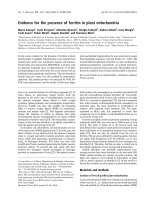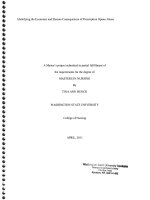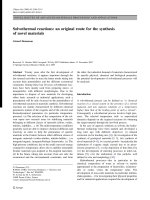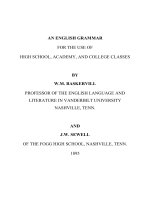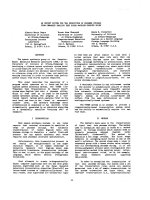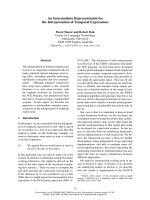An ordered heuristic for the allocation of resources in unrelated parallel-machines
Bạn đang xem bản rút gọn của tài liệu. Xem và tải ngay bản đầy đủ của tài liệu tại đây (371.8 KB, 12 trang )
International Journal of Industrial Engineering Computations 6 (2015) 145–156
Contents lists available at GrowingScience
International Journal of Industrial Engineering Computations
homepage: www.GrowingScience.com/ijiec
An ordered heuristic for the allocation of resources in unrelated parallel-machines
André Serra e Santosa*, Ana Maria Madureirab and Maria Leonilde R. Varelaa
a
Department of Production and Systems - School of Engineering - University of Minho (EEUM/UM), Portugal
GECAD - Knowledge Engineering and Decision Support Research Center - School of Engineering – Polytechnic of Porto (ISEP/IPP), Portugal
b
CHRONICLE
Article history:
Received November 12 2014
Received in Revised Format
November 15 2014
Accepted January 7 2015
Available online
January 9 2015
Keywords:
Scheduling
Makespan
Unrelated Parallel Machines
MCT
MOMCT
ABSTRACT
Global competition pressures have forced manufactures to adapt their productive capabilities. In
order to satisfy the ever-changing market demands many organizations adopted flexible
resources capable of executing several products with different performance criteria. The
unrelated parallel-machines makespan minimization problem (Rm||Cmax) is known to be NPhard or too complex to be solved exactly. In the heuristics used for this problem, the MCT
(Minimum Completion Time), which is the base for several others, allocates tasks in a random
like order to the minimum completion time machine. This paper proposes an ordered approach
to the MCT heuristic. MOMCT (Modified Ordered Minimum Completion Time) will order tasks
in accordance to the MS index, which represents the mean difference of the completion time on
each machine and the one on the minimum completion time machine. The computational study
demonstrates the improved performance of MOMCT over the MCT heuristic.
© 2015 Growing Science Ltd. All rights reserved
1. Introduction
Operations scheduling is a decision process that defines strategies from orders release down to detailed
programming (Baker & Trietsch, 2009; Blazewicz et al., 2001; Pinedo, 2012). Therefore, for determining
how an order will be executed it is necessary to decide when an order should be processed and which
resource should be used for each task. Moreover, the establishment of a production sequence indicating
the tasks’ execution order has also to be considered in order to optimize one or more performance
measures. Consequently, scheduling tries to answer two main questions (Baker & Trietsch, 2009; Pinedo
2012; Xhafa, & Abraham, 2008):
(1). How should tasks be distributed between the available resources in order to optimize the
performance measure(s)?
(2). In which sequence should the tasks be processed to optimize the performance measure(s)?
According to these two main questions, Operations Scheduling can be divided into two main phases, the
allocation phase that answers the first question and the sequencing phase that answers the second one.
There is a strong relation between both phases and it is often hard to clearly distinguish between them.
* Corresponding author. Tel:+351-919231006
E-mail: (A. Serra e Santos)
© 2014 Growing Science Ltd. All rights reserved.
doi: 10.5267/j.ijiec.2015.1.001
146
In problems where the resources are in parallel, the allocation phase is usually addressed before
determining the sequence in which the tasks will be processed. In problems with more complex
implementations, it is harder to separate the allocation phase from the sequencing one, since there is a
correlation between them.
In complex production implementations, the problem constraints and the number of available tasks can
make scheduling operations extremely hard through exact methods (Baker & Trietsch, 2009; Blazewicz
et al., 2001; Pinedo, 2012). Therefore, many different kinds of contributions exist for dealing with these
more complex scenarios, namely web-based systems and platforms, which would integrate a variety of
scheduling approaches and methods, mainly based on heuristic, for solving different types of scheduling
problems. Some examples are described by Varela et al. (2003, 2008, 2012, 2014), which include several
distinct kinds of exact and heuristic scheduling methods. This paper proposes an ordered approach to the
MCT heuristic for unrelated parallel-machines makespan minimization problem (Rm||Cmax) (Pinedo,
2012; Varela et al., 2008), based on the performance limitations of the random like order in which MCT
allocates tasks. The proposed MOMCT is a constructive heuristic, which would construct a schedule from
an empty solution by adding parts to the solution (Briceño, 2008).
In this paper, resources are identified as machines, which execute jobs or tasks, and where the elementary
part of the job or task only requires a single resource is referred as an operation. The scheduling problem
will be represented by the Graham’s classification as described by Pinedo (2012) and Varela et al. (2008).
This classification is represented by three fields, α|β|γ with the first field representing the machine
environment, the second field the process characteristics and constraints and the third field the problem
optimization criterion. This paper is divided into five sections. Section 2 defines the makespan
minimization problem in parallel-machines (Pm||Cmax), in parallel-machines with different speeds
(Qm||Cmax) and in unrelated parallel-machines (Rm||Cmax). Section 3 presents the literature review and
four heuristics for the Rm||Cmax problem. In section 4, the proposed Modified Ordered Minimum
Completion Time heuristic is described. The computational study and a discussion of the achieved results
is presented in section 5. Lastly, the paper presents some conclusions.
2. Problem Definition
The makespan minimization problem in parallel-machines (Pm||Cmax) is known to be NP-hard. It can
describe a machine environment where there are m similar machines in parallel. It is equivalent to the
PARTITION problem (Pinedo 2012). Pm||Cmax is solved by the priority rule LTP (Longest Processing
Time). The problem (Pm||Cmax) is formulated as seen bellow. In this problem the optimization criterion
is to minimize the makespan (Cmax), which is subjected to three constraints, where n is the number of
tasks and m the number of machines. The first (1) forces each task to be allocated to only one machine;
the second (2) defines the makespan as the completion time of the last task to leave the system. The third
(3) forces the decision variables to be non-negative. xij are the decision variables that define which tasks
(j) are allocated to each machine (i), pij is the processing time of task j in machine i.
min Cmax
subject to
m
x
i 1
ij
1,
n
p x
j 1
j ij
Cmax ,
j 1, , n
(1)
i 1, , m
(2)
xij 0
(3)
A. Serra e Santos et al. / International Journal of Industrial Engineering Computations 6 (2015)
147
The makespan minimization problem in parallel-machines with preemptions (Pm|prmp|Cmax) can be
solved exactly since it is possible to divide the execution of tasks among the various machines.
Pm|prmp|Cmax can also be solved by the priority rule LRPT (Longest Remaining Processing Time). The
problem (Pm|prmp|Cmax) is formulated as seen bellow. In the problem the optimization criterion is to
minimize the makespan (Cmax), which is subjected to four constraints. Eq. (4) forces each task to be
executed, Eq. (5) makes sure that each task execution is less than or equal to the makespan. Eq. (6)
ensures that the processing time in each machine is less than or equal to the makespan. Eq. (7) forces the
decision variables to be non-negative.
min Cmax
subject to
m
x
i 1
ij
m
x
i 1
ij
n
x
j 1
ij
pj,
j 1, , n
(4)
Cmax ,
j 1, , n
(5)
Cmax ,
i 1, , m
(6)
xij 0
(7)
The makespan minimization problem in unrelated parallel- machines (Rm||Cmax) is a particular case of
makespan minimization problem in parallel-machines (Pm||Cmax) (Pinedo, 2012). In this problem, the
machine has different characteristics, which means, each machine can have a different processing time
for each task. Unrelated parallel-machines can describe problems in workshops where there are different
machines that can be used to execute the same tasks, which is usual when considering an upgrade to the
installed capacity, or grid-computing problems where computers with different configurations are shared
between various users. The problem (Rm||Cmax) formulation can be seen bellow.
min Cmax
subject to
m
x
i 1
ij
1,
n
p x
i 1
ij ij
xij 0
Cmax ,
j 1, , n
(8)
i 1, , m
(9)
(10)
In this problem the optimization criterion is to minimize the makespan (Cmax), which is subjected to
three constraints, where n is the number of tasks and m the number of machines. Eq. (8) forces each task
to be allocated to only one machine, Eq. (9) defines the makespan as the completion time of the last task
to leave the system. Eq. (10) forces the decision variables to be non-negative. Finally, xij are the decision
variables that define which tasks (j) are allocated to each machine (i), pij is the processing time of task j
in machine i.
148
3. Literature Review
Due to the complexity of the Rm||Cmax problem, many heuristics have been developed. Some of the most
used algorithms, presented in (Ibbara et al. 1997), such as the, MCT Min-Min and Min-Max heuristics
are efficient methods to approach the problem. Braun et al. (2001) presented and compared OLB
(Opportunistic Load Balance), MET (Minimum Completion Time), MCT, Min-Min, Min-Max, Duplex,
GA (Genetic Algorithms), SA (Simulated Annealing), GSA (Genetic Simulated Annealing), Tabu Search
and A*. In the computational study, GA had the best performance and Min-Min the best results between
the constructive heuristics. OLB and MET constructive heuristics had the worse results. Other approaches
(Briceño et al., 2012; Chaturvedi & Sahu 2011; Pfund et al., 2004) to the problem are the Suffrage
heuristics that allocates the tasks that would suffer more when not allocated to their favorite machine
first, KPB (K-Percent Best) and SWA (Switching Algorithm) that combine the MET and MCT heuristics,
WQ (Work Queue) that allocates task to the machine with the minimum work load. DFPLTF (Dynamic
Fastest Processor to Largest Task First) and RR can be used to approach the dynamic Rm||Cmax problem.
Sivasankaran et al. (2010) proposed a local search heuristic. The proposed heuristic consists of two
phases: in the first tasks are allocated to the machines and in the second they are shifted from one machine
to another. Sugavanam et al., (2007) compared SA to GRASP (Greedy Randomized Adaptive Search
Procedure). The computational study found that the SA performed better than the GRASP. Some research
is focused on mixed approaches, which in the first phase use integer programing and in the second phase
use heuristics methods. Hariri et al. (1991) proposed the DA (Descent Algorithm) and Glass et al. (1994)
proposed an altered GA, which applies the DA to each population solution, the GDA (Genetic Descent
Algorithm) is then compared with DA, SA, TS and GA. In the computational study the GDA outperformed
the GA, with results similar to those of SA and TS. The LP/Roundup heuristic is proposed by Lin et al.
(2011), the heuristic solves the LP and then allocates the task to the machines where they have the highest
fraction. In the computational study, the LP/Roundup was compared with MCT, LP/MCT, LP/M and GA.
LP/Roundup performed better than the other constructive heuristics, GA achieved the best results but at
the expense of more computational time.
Lenstra et al. (1990) proposed an approximation algorithm based on LP-relaxation and Martello et al.
(1997) proposed lower bounds based on Lagrangian relaxations to obtain new exact and approximation
algorithms. Ebenlendr et al. (2014) and Verschae et al. (2014) proposed a special case of the Rm||Cmax
problem. In this case each task needs to be allocated to at most two machines and with the similar
execution times (Restrictive Assignment), with a two phase LP/Rounding approach. Vakhania et al.
(2014) proposed another special case of the Rm||Cmax problem, where each task can have two possible
execution (p and q) times. The authors presented a polynomial-time algorithm for q=2p and then
modified to deliver approximated solutions for the p≠2p problem.
In this section, three heuristics for Rm||Cmax will be presented, along with an illustrative example with
three machines (m=3) and four tasks (n=4), seen in Table 1.
Table 1
Illustrative Example
Task 1
Task 2
Task 3
Task 4
Machine 1
100
100
200
160
Machine 2
120
170
300
80
Machine 3
260
270
400
300
3.1.Minimum Execution Time
The MET (Minimum Execution Time) heuristic uses the execution time to allocate tasks. This does not
take into consideration tasks already allocated, what can result in an inefficient solution when several
tasks are allocated to one machine (Braun et al., 2001; Briceño et al., 2012; Ibbara et al., 1997). The MET
algorithm is:
A. Serra e Santos et al. / International Journal of Industrial Engineering Computations 6 (2015)
1.
2.
3.
4.
149
Unmapped task are placed into a list in a random sequence;
The first task is allocated to the minimum execution time machine;
Unmapped task are placed into a list in a random sequence;
Steps II, III and IV are repeated until all tasks have been mapped.
In the illustrative example, MET found a solution (Fig.1) with makespan of 400 t.u, with the allocation
of tasks 1, 2 and 3 into machine 1; the remaining task (task 4) was allocated into machine 2. The solution
is far from the optimal solution that would have a makespan of 260 t.u.
Fig. 1. MET Solution
Fig. 2. MCT Solution
3.2.Minimum Completion Time
The MCT (Minimum Completion Time) heuristic uses the completion time to allocate tasks; this takes
into consideration tasks already allocated, in opposition to MET heuristics (Braun et al., 2001; Briceño
et al., 2012; Ibbara et al., 1997). The MCT algorithm is:
1.
2.
3.
4.
5.
Unmapped tasks are placed into a list in a random sequence;
The first is allocated to the minimum completion time machine;
The task selected in step 2 is removed from the tasks list;
Ready times are updated with assigned task execution time;
Steps II, III and IV are repeated until all tasks have been mapped.
In the illustrative example, MCT found a solution (Fig. 2) with makespan of 300 t.u, with the allocation
of tasks 1 and 3 to machine 1 and tasks 2 and 4 to machine 2.
3.2.Min-Min
The Min-Min heuristic follows a two-phased approach. First, the machines with the minimum completion
time for each task are determined, then, between the task/machine pairs determined in the first step the
one with lowest completion time is allocated. This approach makes this heuristic indifferent to the
sequence in which the tasks are allocated (Braun et al., 2001; Briceño et al., 2012; Chaturvedi & Sahu
2011; Gupta & Singh, 2012) The Min-Min algorithm is:
1.
2.
3.
4.
Unmapped tasks are placed into a list in a random sequence;
For each listed task, the machine that provides the minimum completion time is identified;
For each task/machine pair found in step 2, the one with the minimum completion time is identified;
The task determined in step 3 is removed from the task list and allocated to the selected machine;
150
5. Machine ready times are updated with the assigned task execution time;
6. Steps 2, 3, 4 and 5 are repeated until all tasks have been mapped
In the illustrative example depicted in Fig. 3, Min-Min obtained a solution with makespan of 380 t.u.,
with the allocation of tasks 1 and 2 into machine 1 and tasks 3 and 4 allocated into machine 2. The
obtained solution is far from the optimal solution that would have a makespan of 260 t.u. There are
several other heuristics that use a similar two-phase approach, such as Max-Max or Max-Min heuristics.
Fig. 3. Min-Min Solution
Fig. 4. Suffrage Solution
3.3.Suffrage
Suffrage finds the minimum and second minimum completion time for each task. When there are several
tasks with the minimum completion time in the same machine, the one that would suffer more by being
allocated to the machine with the second best completion time is allocated to the minimal completion
time machine (Briceño et al., 2012; Gupta & Singh, 2012; Paranhos & Brasileiro 2003). Suffrage
allocates first the tasks that would have more impact in the makespan, when they are not allocated to
their favorite machine. The Suffrage algorithm is:
1.Unmapped tasks are placed into a list in a random sequence;
2.While there are still unmapped tasks;
i. For each machine find the tasks that have the minimum completion time on that machine;
a. If there is only one task competing for that machine, allocate it to that machine and remove it from
the tasks list;
b.If there is more than one competing task, allocate the one with the highest Suffrage value and
remove it from the task list;
ii. Machine ready times are updated with the assigned task execution time
The suffrage value can be calculated as seen in Eq. (11), where 2ndMCTM represents the second smallest
completion time and 1stMCTM the smallest completion time machine.
S 2nd MCTM 1st MCTM
(11)
In the illustrative example seen in Fig. 4, Suffrage obtained a solution with makespan of 270 t.u, in three
iterations. Task 3 is allocated to machine 1, task 1 and 4 to machine 2 and task 2 to machine 3.
4. Modified Ordered Minimum Completion Time
The MCT heuristic, performance depends on the random like order in which tasks are allocated. In this
paper, an ordered approach to the MCT heuristic is proposed. Santos et al. (2014) proposed an ordered
A. Serra e Santos et al. / International Journal of Industrial Engineering Computations 6 (2015)
151
approach to MCT. The Ordered Minimum Completion Time (OMCT) will determine a sequence of
allocation before using the MCT algorithm to map tasks. The sequence of allocation will be determined
by the standard deviation of the completion times of all tasks and the Suffrage value. The weighted sum
of the standard deviation of the completion time on each machine and the Suffrage index will allocate
first tasks with the biggest dispersion of their completion time while also taking into consideration the
fact that each task is more likely to be allocated to its preferred machines. In the computational study,
the OMCT heuristic performed better than MCT.
In this paper, a Modified Ordered Minimum Completion Time (MOMCT) is proposed. In this ordered
approach to MCT, tasks are sequenced in non-increasing order of the MS (Mean Suffrage) value. MS is
the difference between the mean of the completion time of a variable number of machines (2º minimum
completion time machine, 3º minimum completion time machine, ..., mº minimum completion time
machine) and the minimum completion time machine. This does not assume that the tasks will be
allocated to their preferred machine. The number of machines considered for the calculation of MS value
should be determined, experimentally. The number of machines use in MS should take in consideration
how likely are tasks to be allocated into their favorite machines. Several factors can contribute to this,
the number of machines (m), the number of tasks (n), the dispersion execution time of tasks between
machines (pj) and the dispersion of execution time of machines between tasks (pi). The MOMCT
algorithm is described as follows:
1.
2.
3.
4.
5.
6.
Calculate the MS value for each task;
Tasks are placed into a list in a decreasing order of their SM value;
The first task is allocated to the minimum completion time machine;
The task selected in step 3 is removed from the tasks list;
Machine ready times are updated with the assigned task execution time;
Steps 3, 4 and 5 are repeated until all tasks have been mapped.
The MS can be calculated as seen in Eq. (12), where a is determined experimentally, between the values
of [2; m]. indMCTM represent the completion time on the ind minimum completion time machine and
1stMCTM the completion time on the minimum completion time machine.
MS
iMCTM
i 2
1
1st MCTM
[2;m]
(12)
In the illustrative example of the MOMCT heuristic (Fig. 8), with a=3, task 3 is allocated to machine 1,
task 2 and task 4 are allocated to machine 2 and task 1 is allocated to machine 3. MOMCT heuristic
obtained the optimal solution with a makespan of 260 t.u.
Fig. 5. MOMCT Solution
152
5. Computational Study
The MCT and MOMCT heuristics were implemented in C in Microsoft Visual Studio 2012 to be
compared and evaluated. The computational tests were performed on a MacBook Air with an Intel®
Core™ 2 @ 1.60 GHz processors, 4 GB of RAM memory and with Windows 7 64-bit as the operative
system with all the available updates. Since the academic benchmark problems as it has been used by
multiple authors and in diverse areas, it was considered an effective evaluation method. Both heuristics
were tested on benchmark instances. MOMCT and MCT heuristics performance was evaluated with three
groups of 20 instances with variable problem size (No. of Machines X No. of Tasks: 2X5,2X6, 2X7,
2X8, 2X9, 3X5, 3X6, 3X7, 3X8, 3X9, 4X5, 4X6, 4X7, 4X8, 4X9, 5X5, 5X6, 5X7, 5X8 and 5X9)
retrieved from Sivasankaran et al. (2010).
5.1.MCT and MOMCT
Both heuristics were compared on their deviation from the optimal makespan, since this allows to
overview the performance of each heuristic across all problems. Since there are 60 problems, the
deviation from the optimal makespan can be assumed to follow a normal distribution, according to
Central Limit Theorem (CLT).
In the computational study MOMCT heuristic performed better than the MCT heuristic. The bar chart
from Fig. 6 depicts the deviation of heuristic obtained solutions from the optimal solution. MOMCT
found the optimal solution in 30 (50%) instances while MCT only found the optimal solution in 21 (35%)
instances.
Fig. 6. Bar chart of the solutions of MCT and MOMCT Fig. 7. Boxplot of the solutions of MCT and MOMCT
The boxplot from Fig. 7 permits to conclude about the advantage of MOMCT heuristic, in terms of
minimization of makespan in the resolution of the analyzed instances. This boxplot allows the analysis
of location, dispersion, median and asymmetry of data of the MOMCT and MCT obtained solutions when
compared to the optimal solution of the problems.
To evaluate the significance of the obtained results the Student’s t-test for independent samples has been
used, considering the hypotheses:
H0: μMCT - μOMCT ≥ 0
H1: μMCT - μOMCT < 0
153
A. Serra e Santos et al. / International Journal of Industrial Engineering Computations 6 (2015)
Table 2 shows the result of the Student’s t-test. It is not possible to assume equal variances (p-value of
0.030) and the student’s t-test has a p-value of 0.022 (0.044/2). From the Student’s t-test, it is possible to
conclude that the MOMCT performs better in problems with more machines, with 95% of confidence
level (p=0.005<).
Table 2
Student’s T Test Results for MCT and MOMCT
Levene's Test for
Equality of
Variances
F
Equal variances assumed
Equal variances not
assumed
4.828
Sig.
0.030
t-test for Equality of Means
t
df
Sig. (2-tailed)
Mean
Difference
Std. Error
Difference
2.035
118
0.044
0.867
0.426
2.035
108.810
0.044
0.867
0.426
5.2. Number of Machines
The MOMCT heuristics performance appeared to depend on the number of machines. In the
computational tests MOMCT seemed to perform better in problems with more machines. This is expected
since the MOMCT heuristic was implemented to sweep all possible a values and due to the fact that
MOMCT does not assume that the tasks will be allocated to their preferred machine taking more machines
in consideration when ordering the tasks. The performance of MOMCT with 2/3 and 4/5 machines, where
compared on their deviation from the makespan of the optimal solution.
In the computational study MOMCT heuristic performed better with more machines (4 and 5). The bar
chart from Fig. 8 depicts the deviation of the heuristic obtained solutions from the optimal solution, with
2/3 and 4/5 machines. With 4/5 machines MOMCT found the optimal solution in 17 (56.7%) instances
while with 2/3 machines it only found the optimal solution in 13 (43.3%) instances.
Fig. 8. Bar chart of the solutions for 2/3 and 4/5 Fig. 9. Boxplot of the solutions for 2/3 and 4/5
machines
machines
154
The boxplot from Fig. 9 permits to conclude that the MOMCT heuristic performs better with 4/5 machines
than with 2/3 machines, in terms of minimization of makespan. The boxplot allows the analysis of
location, dispersion, median and asymmetry of MOMCT with a variable number of machines.
To evaluate the significance of the obtained results the Student’s t-test for independent samples has been
used, considering the hypotheses:
H0: μ2/3 – μ4/5 ≥ 0
H1: μ2/3 – μ4/5 < 0
Table 3 shows the result of the Student’s t-test. It is not possible to assume equal variances (p-value of
0.000) and the Student’s t-test has a p-value of 0.005 (0.010/2). The null hypothesis H0, that considers
the non-existence of difference between the performances on 4/5 and 2/3 machines was rejected
(p=0.005<). This permits to conclude, with 95% of confidence that the MOMCT heuristic performs
better in problems with more machines.
Table 3
Student’s T Test Results for 2/3 and 4/5 machines
Levene's Test for
Equality of Variances
Equal variances
assumed
t-test for Equality of Means
F
Sig.
t
df
Sig. (2-tailed)
Mean
Difference
Std. Error
Difference
19.975
0.000
-2.696
58
0.009
-1.300
0.482
-2.696
38.910
0.01
-1.300
0.482
Equal variances not
assumed
6. Conclusions
In this paper, the makespan minimization problem in unrelated parallel-machines was analyzed. Some of
the heuristics used to solve the problem were described and compared and a new heuristic was proposed.
MCT performance depends on a random like order in which tasks are allocated. The possibility of ordering
tasks before applying the MCT was studied in the proposed heuristic.
The MOMCT heuristic orders tasks in accordance to the difference between the mean of the completion
time of a variable number of machines and the completion time on the minimum completion time
machine. This does not assume that the tasks would be allocated to their preferred machine as several
machines can be used to determine in which order tasks would be allocated to machines. Experimental
analysis was performed in order to validate the performance of the proposed MOMCT heuristic. From
the obtained results, it is possible to conclude that MOMCT found better solutions than MCT with a
deviation of 3.00%. MOMCT found the optimal solution in 30 (50%) instances while MCT only found
the optimal solution in 21 (35%) instances. From the obtained results it was possible to conclude with
statistical evidence, through the Student’s t-test, that the MOMCT was more effective than the MCT
heuristic, with a 95% confidence level. The proposed heuristic performance seems to be dependent on
the number of machines in the problem. In the computational study MOMCT found the optimal solution
in 17 (56.7%) for 4/5 machines and 13 (43.3%) for 2/3 machines. From the Student’s t-test it is possible
to conclude that the MOMCT performs better in problems with more machines, with 95% of confidence
level (p=0.005<). This is expected since the MOMCT does not assume that the tasks will be allocated
to their preferred machine and will sweep all possible a values to determine the allocation sequence.
Future work should focus on more computational tests that will compare the performance of the proposed
heuristic with other heuristics described in the literature. Moreover, additional emphasize will be given
A. Serra e Santos et al. / International Journal of Industrial Engineering Computations 6 (2015)
155
to compare the performance of the proposed heuristic when dealing with problems of different sizes and
the formulation of how the performance of MOMCT depends on the number of machines used to order
tasks in problems with different characteristics will also be further explored.
Acknowledgements
This work is supported by FEDER Funds through the “Programa Operacional Factores de
Competitividade - COMPETE” program and by National Funds through FCT “Fundação para a Ciência
e a Tecnologia” under the project: FCOMP-01-0124-FEDER-PEst-OE/EEI/UI0760/2011 and PEstOE/EEI/UI0760/2014.
References
Baker, K. R., & Trietsch, D. (2009). Principles of Sequencing and Scheduling (First Edition). Wiley.
Blazewicz, A.J., Ecker, K. H., Pesh, E., Schmidt, G., & Weglarz, J. (2001). Scheduling Computer and
Manufacturing Process (Second Edition). Springer.
Braun, T. D., Siegel, H. J., Beck, N., Bölöni, L. L., Maheswaran, M., Reuther, A. I., ... & Freund, R. F.
(2001). A comparison of eleven static heuristics for mapping a class of independent tasks onto
heterogeneous distributed computing systems. Journal of Parallel and Distributed computing, 61(6),
810-837.
Briceño, L. D., Siegel, H. J., Maciejewski, A. A., & Oltikar, M. (2012). Characterization of the iterative
application of makespan heuristics on non-makespan machines in a heterogeneous parallel and
distributed environment. The Journal of Supercomputing, 62(1), 461-485.
Ebenlendr, T., Krčál, M., & Sgall, J. (2014). Graph balancing: A special case of scheduling unrelated
parallel machines. Algorithmica, 68(1), 62-80.
Chaturvedi, A. K., & Sahu, R. (2011). New heuristic for scheduling of independent tasks in
computational grid. International Journal of Grid and Distributed Computing, 4(3), 25-36.
Fujimoto, N., & Hagihara, K. (2004). A Comparison among grid scheduling algorithms for independent
coarse-grained tasks. SAINT Workshops, 674-680.
Glass, C. A., Potts, C. N., & Shade, P. (1994). Unrelated parallel machine scheduling using local search.
mathematical. Computer Modeling, 20(2), 41-52.
Gupta, K., & Singh, M. (2012). Heuristic based task scheduling in grid. International Journal of
Engineering and Technology, 4(4), 254-260.
Hariri, A., & Potts, C. (1991). Heuristics for scheduling unrelated parallel-machines. Computers and
Operations Research, 18(3), 323–331.
Ibbara, O., & Kim, C. (1977). Heuristic algorithms for scheduling independent tasks of no identical
processors. Journal of Association for Computing Machinery, 24(2), 280-289.
Lenstra, J. K., Shmoys, D. B., & Tardos, E. (1990). Approximation algorithms for scheduling unrelated
parallel machines. Mathematical Programming, 46(1-3), 256-271.
Lin, Y. K., Pfund, M. E., & Flower, J. W. (2011). Heuristics for minimizing regular performance
measures in unrelated parallel machine scheduling problems. Computer & Operations Research,
38(6), 901-916.
Martello, S., Soumis, F., & Toth, P. (1997). Exact and approximation algorithms for makespan
minimization on unrelated parallel machines. Discrete Applied Mathematics, 75(2), 169-188.
Paranhos, D., Cirne, W., & Brasileiro, F. V. (2003). Trading cycles for information: Using replication to
schedule bag-of-tasks application on computational grids. International Conference on Parallel and
Distributed Computing, 2790, 169-180.
Pfund, M., Flower, J. W., Jatinder, & Gupta, J. N. D. (2004). A survey of algorithms for single and multiobjective unrelated parallel-machine deterministic scheduling problems. Journal of the Chinese
Institute of Industrial Engineers, 21(3), 230-241.
156
Pinedo, M. L. (2012). Scheduling Theory, Algorithms, and Systems (Fourth Edition). Springer.
Serra e Santos, & A., Madureira, A. M. (2014). Ordered minimum completion time heuristic for unrelated
parallel-machines. Proceedings of the 9th Iberian Conference on Information Systems and
Technologies (CISTI2014), 695-700.
Sivasankaran, P., Sornakumar, T., & Panneerselvam, R. (2010). Efficient heuristic to minimize makespan
in single machine scheduling problem with unrelated parallel machines. Intelligent Information
Management, 2, 188-198.
Sugavanam, P., Siegel, H. J., Maciejewski, A. A., Oltikar, M., Mehta, A., Pichel, R., ... & Pippin, A.
(2007). Robust static allocation of resources for independent tasks under makespan and dollar cost
constraints. Journal of Parallel and Distributed Computing, 67(4), 400-416.
Vakhania, N., Hernandez, J. A., & Werner, F. (2014). Scheduling unrelated machines with two types of
jobs. International Journal of Production Research, 52(13), 3793-3801.
Varela, L. R., & Ribeiro, R. A., (2003). Evaluation of simulated annealing to solve fuzzy optimization
problems, Journal of Intelligent & Fuzzy Systems, 14(2), 59-71.
Varela, M.L.R., Aparício, J.N., & Silva, S.C. (2003), A web-based application for manufacturing
scheduling. Proceedings of the International Conference on Intelligent Systems and Control
(IASTED), 400- 405.
Varela, M. L. R., & Carmo-Silva, S. (2008). An ontology for a model of manufacturing scheduling
problems to be solved on the web. Innovation in Manufacturing Networks, 8th IFIP International
Conference on Information Technology for Balanced Automation Systems. Azevedo, A. (Ed.);
Springer, 197-204.
Varela, M. L. R., Barbosa, R., & Putnik, Goran (2012). Experimental platform for collaborative inter and
intra cellular fuzzy scheduling in an ubiquitous manufacturing system, Proceedings of the First
International Conference on Virtual and Network Organizations Emergent Technologies and Tools
(ViNOrg'11), 227-236.
Varela, M. L. R., Putnik G. D., & Cruz-Cunha M. M., (2012) Web-based technologies integration for
distributed manufacturing scheduling in a virtual enterprise. International Journal of Web Portals, 4(
2), 19-39.
Varela, M. L. R., Putnik, G. D, & Ribeiro, R. A. (2012). A web-based platform for collaborative
manufacturing scheduling in a virtual enterprise. Information and Communication Technologies for
the Advanced Enterprise an international journal, 2, 87-108.
Varela, M. L. R., & Ribeiro, R. A. (2014), Distributed manufacturing scheduling based on a dynamic
multi-criteria decision model. Studies in Fuzziness and Soft Computing, 317, 81-93.
Verschae, J., & Wiese, A. (2014). On the configuration-LP for scheduling on unrelated machines.
Journal of Scheduling, 17, 371-383.
Xhafa, F., & Abraham, A. (2008). Metaheuristics for scheduling in industrial and manufacturing
applications series: Studies in computational intelligence, 128, Springer.




